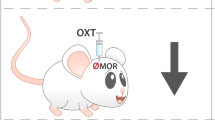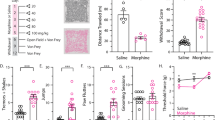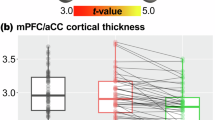Abstract
The main challenge in treating opioid addicts is to maintain abstinence due to the affective consequences associated with withdrawal which may trigger relapse. Emerging evidence suggests a role of the neurohypophysial peptide oxytocin (OT) in the modulation of mood disorders as well as drug addiction. However, its involvement in the emotional consequences of drug abstinence remains unclear. We investigated the effect of 7-day opioid abstinence on the oxytocinergic system and assessed the effect of the OT analogue carbetocin (CBT) on the emotional consequences of opioid abstinence, as well as relapse. Male C57BL/6J mice were treated with a chronic escalating-dose morphine regimen (20–100 mg/kg/day, i.p.). Seven days withdrawal from this administration paradigm induced a decrease of hypothalamic OT levels and a concomitant increase of oxytocin receptor (OTR) binding in the lateral septum and amygdala. Although no physical withdrawal symptoms or alterations in the plasma corticosterone levels were observed after 7 days of abstinence, mice exhibited increased anxiety-like and depressive-like behaviors and impaired sociability. CBT (6.4 mg/kg, i.p.) attenuated the observed negative emotional consequences of opioid withdrawal. Furthermore, in the conditioned place preference paradigm with 10 mg/kg morphine conditioning, CBT (6.4 mg/kg, i.p.) was able to prevent the stress-induced reinstatement to morphine-seeking following extinction. Overall, our results suggest that alterations of the oxytocinergic system contribute to the mechanisms underlying anxiety, depression, and social deficits observed during opioid abstinence. This study also highlights the oxytocinergic system as a target for developing pharmacotherapy for the treatment of emotional impairment associated with abstinence and thereby prevention of relapse.
Similar content being viewed by others
Log in or create a free account to read this content
Gain free access to this article, as well as selected content from this journal and more on nature.com
or
References
Anraku T, Ikegaya Y, Matsuki N, Nishiyama N (2001). Withdrawal from chronic morphine administration causes prolonged enhancement of immobility in rat forced swimming test. Psychopharmacology 157: 217–220.
Bailey A, Metaxas A, Al-Hasani R, Keyworth HL, Forster DM, Kitchen I (2010). Mouse strain differences in locomotor, sensitisation and rewarding effect of heroin; association with alterations in MOP-r activation and dopamine transporter binding. Eur J Neurosci 31: 742–753.
Broadbear JH, Tunstall B, Beringer K (2011). Examining the role of oxytocin in the interoceptive effects of 3,4-methylenedioxymethamphetamine (MDMA, 'ecstasy') using a drug discrimination paradigm in the rat. Addict Biol 16: 202–214.
Carson DS, Cornish JL, Guastella AJ, Hunt GE, McGregor IS (2010). Oxytocin decreases methamphetamine self-administration, methamphetamine hyperactivity, and relapse to methamphetamine-seeking behaviour in rats. Neuropharmacology 58: 38–43.
Carter CS (2007). Sex differences in oxytocin and vasopressin: implications for autism spectrum disorders? Behav Brain Res 176: 170–186.
Chaviaras S, Mak P, Ralph D, Krishnan L, Broadbear JH (2010). Assessing the antidepressant-like effects of carbetocin, an oxytocin agonist, using a modification of the forced swimming test. Psychopharmacology 210: 35–43.
Christensson-Nylander I, Nyberg F, Ragnarsson U, Terenius L (1985). A general procedure for analysis of proenkephalin B derived opioid peptides. Regul Peptides 11: 65–76.
Cordery SF, Taverner A, Ridzwan IE, Guy RH, Delgado-Charro MB, Husbands SM et al (2012). A non-rewarding, non-aversive buprenorphine/naltrexone combination attenuates drug-primed reinstatement to cocaine and morphine in rats in a conditioned place preference paradigm. Addict Biol doi:10.1111/adb.12020.
Craft RM, Kostick ML, Rogers JA, White CL, Tsutsui KT (2010). Forced swim test behavior in postpartum rats. Pharmacol Biochem Behav 96: 402–412.
Dawe S, Davis P, Lapworth K, McKetin R (2009). Mechanisms underlying aggressive and hostile behavior in amphetamine users. Curr Opin Psychiatr 22: 269–273.
Domes G, Heinrichs M, Glascher J, Buchel C, Braus DF, Herpertz SC (2007). Oxytocin attenuates amygdala responses to emotional faces regardless of valence. Biol Psychiatr 62: 1187–1190.
Engstrom T, Barth T, Melin P, Vilhardt H (1998). Oxytocin receptor binding and uterotonic activity of carbetocin and its metabolites following enzymatic degradation. Eur J Pharmacol 355: 203–210.
Erb S (2010). Evaluation of the relationship between anxiety during withdrawal and stress-induced reinstatement of cocaine seeking. Prog Neuro-psychopharm 34: 798–807.
Erb S, Salmaso N, Rodaros D, Stewart J (2001). A role for the CRF-containing pathway from central nucleus of the amygdala to bed nucleus of the stria terminalis in the stress-induced reinstatement of cocaine seeking in rats. Psychopharmacology 158: 360–365.
Erb S, Shaham Y, Stewart J (1998). The role of corticotropin-releasing factor and corticosterone in stress- and cocaine-induced relapse to cocaine seeking in rats. J Neurosci 18: 5529–5536.
Gimpl G, Fahrenholz F (2001). The oxytocin receptor system: structure, function, and regulation. Physiol Rev 81: 629–683.
Goeldner C, Lutz PE, Darcq E, Halter T, Clesse D, Ouagazzal AM et al (2011). Impaired emotional-like behavior and serotonergic function during protracted abstinence from chronic morphine. Biol Psychiatry 69: 236–244.
Heinrichs M, Domes G (2008). Neuropeptides and social behaviour: effects of oxytocin and vasopressin in humans. Prog Brain Res 170: 337–350.
Heinrichs M, Gaab J (2007). Neuroendocrine mechanisms of stress and social interaction: implications for mental disorders. Curr Opin Psychiatr 20: 158–162.
Heinrichs SC, Menzaghi F, Schulteis G, Koob GF, Stinus L (1995). Suppression of corticotropin-releasing factor in the amygdala attenuates aversive consequences of morphine withdrawal. Behav Pharmacol 6: 74–80.
Jaffe JH (1990). Trivializing dependence. Br J Addict 85: 1425–1427 Discussion 1429-1431.
Keverne EB, Curley JP (2004). Vasopressin, oxytocin and social behaviour. Curr Opin Neurobiol 14: 777–783.
Koob G, Kreek MJ (2007). Stress, dysregulation of drug reward pathways, and the transition to drug dependence. Am J Psychiatry 164: 1149–1159.
Koob GF (2008). A role for brain stress systems in addiction. Neuron 59: 11–34.
Koob GF (2009). Brain stress systems in the amygdala and addiction. Brain Res 1293: 61–75.
Kovacs CL, Van Ree JM (1985). Behaviorally active oxytocin fragments simultaneously attenuate heroin self-administration and tolerance in rats. Life Sci 37: 1895–1900.
Kovacs GL, Horvath Z, Sarnyai Z, Faludi M, Telegdy G (1985). Oxytocin and a C-terminal derivative (Z-prolyl-D-leucine) attenuate tolerance to and dependence on morphine and interact with dopaminergic neurotransmission in the mouse brain. Neuropharmacology 24: 413–419.
Kovacs GL, Izbeki F, Horvath Z, Telegdy G (1984). Effects of oxytocin and a derivative (Z-prolyl-D-leucine) on morphine tolerance/withdrawal are mediated by the limbic system. Behav Brain Res 14: 1–8.
Kovacs GL, Laczi F, Vecsernyes M, Hodi K, Telegdy G, Laszlo FA (1987). Limbic oxytocin and arginine 8-vasopressin in morphine tolerance and dependence. Exp Brain Res 65: 307–311.
Kovacs GL, Sarnyai Z, Barbarczi E, Szabo G, Telegdy G (1990). The role of oxytocin-dopamine interactions in cocaine-induced locomotor hyperactivity. Neuropharmacology 29: 365–368.
Le Moal M, Koob GF (2007). Drug addiction: pathways to the disease and pathophysiological perspectives. Eur Neuropsychopharmacol 17: 377–393.
Lee PR, Brady DL, Shapiro RA, Dorsa DM, Koenig JI (2005). Social interaction deficits caused by chronic phencyclidine administration are reversed by oxytocin. Neuropsychopharmacology 30: 1883–1894.
Liu JCJ, McErlean RA, Dadds MR (2012). Are we there yet? The clinical potential of intranasal oxytocin in psychiatry. Curr Psychiatr Rev 8: 37–48.
Lukas M, Toth I, Reber SO, Slattery DA, Veenema AH, Neumann ID (2011). The neuropeptide oxytocin facilitates pro-social behavior and prevents social avoidance in rats and mice. Neuropsychopharmacology 36: 2159–2168.
Lukas M, Toth I, Veenema AH, Neumann ID (2013). Oxytocin mediates rodent social memory within the lateral septum and the medial amygdala depending on the relevance of the social stimulus: male juvenile versus female adult conspecifics. Psychoneuroendocrinology 38: 916–926.
Mantsch JR, Weyer A, Vranjkovic O, Beyer CE, Baker DA, Caretta H (2010). Involvement of noradrenergic neurotransmission in the stress- but not cocaine-induced reinstatement of extinguished cocaine-induced conditioned place preference in mice: role for beta-2 adrenergic receptors. Neuropsychopharmacology 35: 2165–2178.
Martin WR, Jasinski DR (1969). Physiological parameters of morphine dependence in man—tolerance, early abstinence, protracted abstinence. J Psychiatr Res 7: 9–17.
McGregor IS, Bowen MT (2012). Breaking the loop: oxytocin as a potential treatment for drug addiction. Horm Behav 61: 331–339.
McGregor IS, Callaghan PD, Hunt GE (2008). From ultrasocial to antisocial: a role for oxytocin in the acute reinforcing effects and long-term adverse consequences of drug use? Br J Pharmacol 154: 358–368.
Muller DL, Unterwald EM (2004). In vivo regulation of extracellular signal-regulated protein kinase (ERK) and protein kinase B (Akt) phosphorylation by acute and chronic morphine. J Pharmacol Exp Ther 310: 774–782.
Neumann ID, Landgraf R (2012). Balance of brain oxytocin and vasopressin: implications for anxiety, depression, and social behaviors. Trends Neurosci 35: 649–659.
Nunes EV, Sullivan MA, Levin FR (2004). Treatment of depression in patients with opiate dependence. Biol Psychiatry 56: 793–802.
Peles E, Schreiber S, Naumovsky Y, Adelson M (2007). Depression in methadone maintenance treatment patients: rate and risk factors. J Affect Disord 99: 213–220.
Phelps EA, LeDoux JE (2005). Contributions of the amygdala to emotion processing: from animal models to human behavior. Neuron 48: 175–187.
Qi J, Yang JY, Song M, Li Y, Wang F, Wu CF (2008). Inhibition by oxytocin of methamphetamine-induced hyperactivity related to dopamine turnover in the mesolimbic region in mice. Naunyn Schmiedebergs Arch Pharmacol 376: 441–448.
Qi J, Yang JY, Wang F, Zhao YN, Song M, Wu CF (2009). Effects of oxytocin on methamphetamine-induced conditioned place preference and the possible role of glutamatergic neurotransmission in the medial prefrontal cortex of mice in reinstatement. Neuropharmacology 56: 856–865.
Redila VA, Chavkin C (2008). Stress-induced reinstatement of cocaine seeking is mediated by the kappa opioid system. Psychopharmacology 200: 59–70.
Sarnyai Z (2011). Oxytocin as a potential mediator and modulator of drug addiction. Addict Biol 16: 199–201.
Sarnyai Z, Viski S, Krivan M, Szabo G, Kovacs GL, Telegdy G (1988). Endogenous oxytocin inhibits morphine tolerance through limbic forebrain oxytocin receptors. Brain Res 463: 284–288.
Singewald GM, Rjabokon A, Singewald N, Ebner K (2011). The modulatory role of the lateral septum on neuroendocrine and behavioral stress responses. Neuropsychopharmacology 36: 793–804.
Stinus L, Cador M, Zorrilla EP, Koob GF (2005). Buprenorphine and a CRF1 antagonist block the acquisition of opiate withdrawal-induced conditioned place aversion in rats. Neuropsychopharmacology 30: 90–98.
Szeto A, McCabe PM, Nation DA, Tabak BA, Rossetti MA, McCullough ME et al (2011). Evaluation of enzyme immunoassay and radioimmunoassay methods for the measurement of plasma oxytocin. Psychosom Med 73: 393–400.
Veilleux JC, Colvin PJ, Anderson J, York C, Heinz AJ (2010). A review of opioid dependence treatment: pharmacological and psychosocial interventions to treat opioid addiction. Clin Psychol Rev 30: 155–166.
Volkow ND, Baler RD, Goldstein RZ (2011). Addiction: pulling at the neural threads of social behaviors. Neuron 69: 599–602.
Wang J, Fang Q, Liu Z, Lu L (2006). Region-specific effects of brain corticotropin-releasing factor receptor type 1 blockade on footshock-stress- or drug-priming-induced reinstatement of morphine conditioned place preference in rats. Psychopharmacology 185: 19–28.
Windle RJ, Kershaw YM, Shanks N, Wood SA, Lightman SL, Ingram CD (2004). Oxytocin attenuates stress-induced c-fos mRNA expression in specific forebrain regions associated with modulation of hypothalamo-pituitary-adrenal activity. J Neurosci 24: 2974–2982.
You ZD, Li JH, Song CY, Wang CH, Lu CL (2000). Chronic morphine treatment inhibits oxytocin synthesis in rats. Neuroreport 11: 3113–3116.
Zanos P, Wright SR, Georgiou P, Yoo JH, Ledent C, Hourani S et al (2013). Chronic methamphetamine treatment induces oxytocin receptor up-regulation in the amygdala and hypothalamus via an adenosine A2A receptor-independent mechanism. Pharmacol Biochem Behav S0091-3057: 00125–1.
Zhou Y, Bendor J, Hofmann L, Randesi M, Ho A, Kreek MJ (2006). Mu opioid receptor and orexin/hypocretin mRNA levels in the lateral hypothalamus and striatum are enhanced by morphine withdrawal. J Endocrinol 191: 137–145.
Acknowledgements
We thank Prof Ingrid Nylander for valuable advice on OT peptide measurements, Dr Sheryl Moy and Ms Pamela Farshim for advice given on the behavioral tests, as well as Dr van der Veen and Helen Keyworth for advice on statistical analyses. This study was supported by Spyroula and Soteris Zanos, Lilia and Charalambos Georgiou and by a Royal Society grant (RG120556; P.I. Alexis Bailey). We declare that over the past 3 years PZ has received financial support from Mr and Mrs Zanos and PG has received financial support from Mr and Mrs Georgiou. The sponsors had no involvement in the design of the study and in the collection, analyses, and interpretation of the data, nor in the writing of the report and the decision to submit this article for publication. PZ, PG, SRW, SMH, IK, RWS, AB wrote the paper; PZ, PG performed the experiments; PZ, PG, RWS analysed the data; AB, PZ, PG designed the experiments; AB conceived the idea for the experiments and was PI for the study.
Author information
Authors and Affiliations
Corresponding author
Additional information
Supplementary Information accompanies the paper on the Neuropsychopharmacology website
Rights and permissions
About this article
Cite this article
Zanos, P., Georgiou, P., Wright, S. et al. The Oxytocin Analogue Carbetocin Prevents Emotional Impairment and Stress-Induced Reinstatement of Opioid-Seeking in Morphine-Abstinent Mice. Neuropsychopharmacol 39, 855–865 (2014). https://doi.org/10.1038/npp.2013.285
Received:
Revised:
Accepted:
Published:
Issue date:
DOI: https://doi.org/10.1038/npp.2013.285
Keywords
This article is cited by
-
Functional modular networks identify the pivotal genes associated with morphine addiction and potential drug therapies
BMC Anesthesiology (2023)
-
The Use of Oxytocin for the Treatment of Opioid Use Disorder
Current Pain and Headache Reports (2023)
-
Oxytocin and orexin systems bidirectionally regulate the ability of opioid cues to bias reward seeking
Translational Psychiatry (2022)
-
Facilitating mGluR4 activity reverses the long-term deleterious consequences of chronic morphine exposure in male mice
Neuropsychopharmacology (2021)
-
Increased Response to 3,4-Methylenedioxymethamphetamine (MDMA) Reward and Altered Gene Expression in Zebrafish During Short- and Long-Term Nicotine Withdrawal
Molecular Neurobiology (2021)



